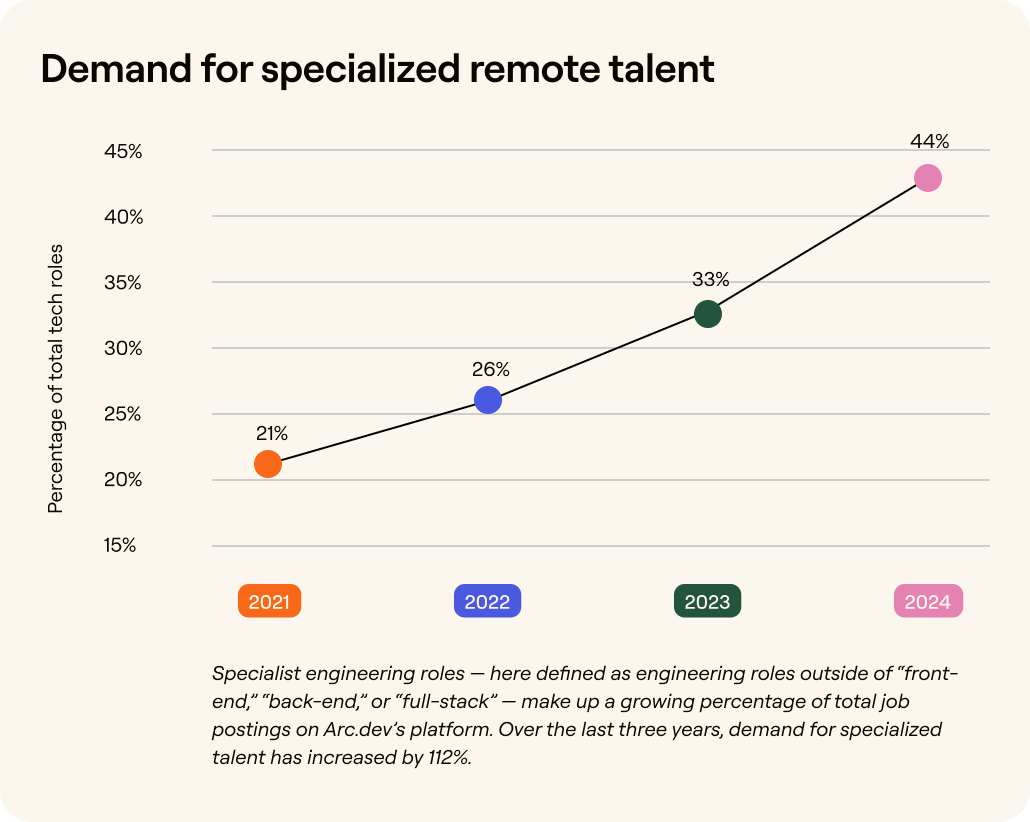HR leaders are still struggling to find the tech talent they need, despite huge layoffs.
At the root cause of the problem is a shift in focus… Companies are increasingly looking for specialized skills rather than generalized tech talent. “If you look at the number of people with computer science degrees, there’s actually too much tech talent,” Matt Charney, Editor in Chief at Recruiter.com says, “The real problem is that coding is no longer enough.”
Why have organizations changed their focus? What does this mean for the future of the tech job market? And how can you adapt to find the tech talent you need to stay ahead?
These are the questions we’ll explore in this guide alongside insights from Matt Charney. For further insights, be sure to check out our webinar: “Hiring global tech talent in a shortage.”
Why are specialized skills so in demand?
In recent years, companies have been hiring more specialized skills. In fact, in the last three years specialist job postings on Arc.dev’s recruitment platform have grown by 111.89%. In this example, specialized job roles refer to anything other than Back-End,” “Front-End,” or ‘Full Stack” developers. Find out more in our e-book: “The tech talent evolution.”
Let’s take a closer look at what’s behind this shift in strategy.
Shifting economic winds
“There’s an arms race for niche skills,” Charney says. “Companies are no longer just looking for workers who can code, but instead focusing on finding the talent that can help them leverage emerging technologies and grow”
This shift towards specialized skills in the tech job market can be traced back to the COVID-19 pandemic. With an increasing number of companies dependent on technology to work remotely, many increased their budgets. Meanwhile, tech stocks skyrocketed as investors predicted long-term demand.
With investment high, companies could afford to hire high numbers of tech workers and place them in roles that didn’t directly generate revenue. However, when the US government increased interest rates 11 times between 2022 and 2023, investment dropped. Companies were forced to scale back and focus more on revenue-generating areas. This often meant laying off talent lacking in specialized skills as companies looked more to high-growth emerging technologies such as generative AI and data science.
The rise of artificial intelligence: A double-edged sword
Artificial intelligence is making areas of traditional tech work redundant. To take an example, 31% of job roles posted in 2024 indicated a reduced need for basic programming and language skills, signaling a shift toward machine learning and natural language processing.
At the same time, however, companies are searching for the specialized skills that allow them to develop, implement, and optimize these AI solutions. Research from Arc.dev shows that demand for generative AI roles alone has grown by 13X in the last two years while AI roles in data science and machine learning have grown by 80% and 250%, respectively.
As demand for AI-related roles has grown, there has also been growth in demand for AI skills in jobs more broadly. In 2022, just 9% of jobs posted on Arc.dev’s platform listed AI skill requirements; by 2024, 21% of companies listed them as key skills – a 130% increase.
How can companies adapt to skills shortages?
With an increasing number of companies looking for the same pool of specialized skills, shortages inevitably become an issue. As Jeff Lam, Director of Recruiting at Arc.dev explained in our recent webinar, “If you’re looking for a generalized skill, you’ll usually get hundreds of applicants. However, only a handful will have the right specialized skills.” In this section, we look at how companies can adapt to find the talent they need.
Skills-based hiring
This shift also allows organizations to tap into a wider talent pool, aiding equality and opening opportunities for a diverse range of candidates. In the tech industry, which has historically been composed of large amounts of self-taught talent, this is especially important.
Implement upskilling programs
“Organizations need to remember that tech workers with years of experience or traditional academic qualifications in emerging technologies just don’t exist,” Charney describes. “This means a priority should be continuous learning.”
Investing in training programs and certifications allows you to stay competitive in a rapidly changing market. As Charney points out, upskilling is also a great retention driver.
This process of nurturing talent can begin before you even hire employees. By partnering with educational institutions, companies can begin to build a pipeline of talent that has specialized skills. As Alycia Damp explains in our webinar, “It’s important for companies to create a dialogue about what they need so institutions can frame their curriculum around new technologies as well as theoretical learning.”
Build global teams
Rather than competing for a small pool of talent, companies are broadening their search and sourcing skills across the globe. “Companies need to get out of the hunger games for talent,” Charney says, “Tech is truly borderless.”
Global hiring allows you to add new perspectives, avoid downtime, and leverage previously unavailable skills — and it’s never been easier. Companies that want to tap into the global talent pool without taking on a heavy administrative burden can use an Employer of Record solution to hire, onboard, and manage employees all over the world – without setting up a local entity.
Companies are increasingly using our EOR to hire in emerging markets like Pakistan and the Philippines. This allows them to save money while finding the specialized skills they need.
Strengthen your talent acquisition strategy
In a competitive landscape, hiring fundamentals become even more essential to attracting talent. This means staying on top of tech salary benchmarks and providing great, localized benefits.
You should also implement flexible work practices that go beyond remote work policies. Over 95% of tech companies already offer work location flexibility, so this alone isn’t enough to secure top talent. Instead, you could consider offering four-day workweeks, for example.
Tie this all together by creating an attractive employer brand. By defining what your company really stands for and what it offers employees, you can set it apart, catch candidates’ eyes, and encourage existing employees to refer you.
Dynamic workforce planning
When budgets are tight and competition is high, companies need a carefully balanced approach to talent acquisition. Onboarding freelancers provides access to specialized skills at a lower total cost but comes with decreased stability. Meanwhile, hiring permanent staff gives companies the ability to invest in employees and upskill to meet future needs.
A dynamic approach to workforce planning combines both, helping companies source skills relating to emerging technology while continually adapting to market needs and internal changes. As Jeff Lam put it in our webinar, “a mix of freelance and full-time talent allows you to stay agile.”
Keeping up with the pace of change
As the tech industry continues to evolve at a rapid pace, those that keep up are defined by their flexibility and agility. With skills-based hiring, global talent sourcing, and a dynamic approach to workforce planning, you can move more quickly and match your team to both internal needs and market demands.










